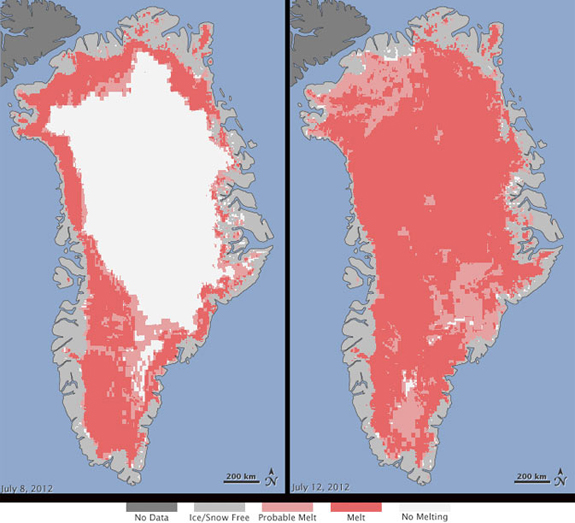Why 97 Percent Of Greenland’s Icy Surface Just Melted
/https://tf-cmsv2-smithsonianmag-media.s3.amazonaws.com/filer/2012072511100607_25_2012_greenland.jpg)
Over the course of a four day blitz that started on July 8th, surface melting of Greenland’s vast glaciers went from affecting 40 percent of the surface area up to a staggering 97 percent.
The intense melting trumps anything seen before during the 30 year history of satellite observations, and NASA researchers think it is a unique event in at least the past 123 years. As the Associated Press‘ Seth Borenstein said: “Even Greenland’s coldest and highest place, Summit station, showed melting.”

This map shows the huge difference in where Greenland’s glaciers were melting between July 8th (left) and July 12th (right) Photo: NASA
What this anomalous melting actually means isn’t so clear. Though 97 percent of the surface saw some amount of melting, Borenstein reports that it seems to be refreezing. Further, NASA glaciologist Lora Koenig says that events like this happen “about once every 150 years on average.”
Greenland’s glaciers have been steadily losing mass over the past decade or more, but this month’s rapid melting was driven more by large-scale atmospheric patterns than anything else. According to Borenstein,
Summer in Greenland has been freakishly warm so far. That’s because of frequent high pressure systems that have parked over the island, bringing warm clear weather that melts ice and snow, explained University of Georgia climatologist Thomas Mote.
When a high pressure system is trapped in one spot in the upper atmosphere for a long time, an occurrence caused by something called atmospheric blocking, bad things can happen. The National Center for Atmospheric Research describes atmospheric blocking:
Every so often, a dome of upper-level high pressure sits in place for a few days, sometimes as long as several weeks. A major block can produce seemingly endless stretches of blazing heat or bitter cold. It also blocks the typical eastward flow of the polar jet stream (thus the label “blocking”) and throws storm systems far from their usual tracks. Along those displaced paths, the storms can generate successive bouts of heavy rain or snow. By the time it dissipates, a major block may leave behind a whole stack of broken weather records and an array of disastrous consequences.
Just in the past few years, atmospheric blocking has been linked to 2010′s deadly Russian wildfires, flooding in Pakistan, the 2003 European heat wave, and the ongoing extreme temperatures and drought across the continental United States.
For now the freak melting can probably be considered the result of a strong atmospheric event stacked on top of a known natural cycle. “But,” says NASA glaciologist Koenig, “if we continue to observe melting events like this in upcoming years, it will be worrisome.”
Talking to Borenstein, NASA’s chief scientist Waleed Abdalati says,
When we see melt in places that we haven’t seen before, at least in a long period of time, it makes you sit up and ask what’s happening?
More from Smithsonian.com:
/https://tf-cmsv2-smithsonianmag-media.s3.amazonaws.com/accounts/headshot/smartnews-colin-schultz-240.jpg)
/https://tf-cmsv2-smithsonianmag-media.s3.amazonaws.com/accounts/headshot/smartnews-colin-schultz-240.jpg)